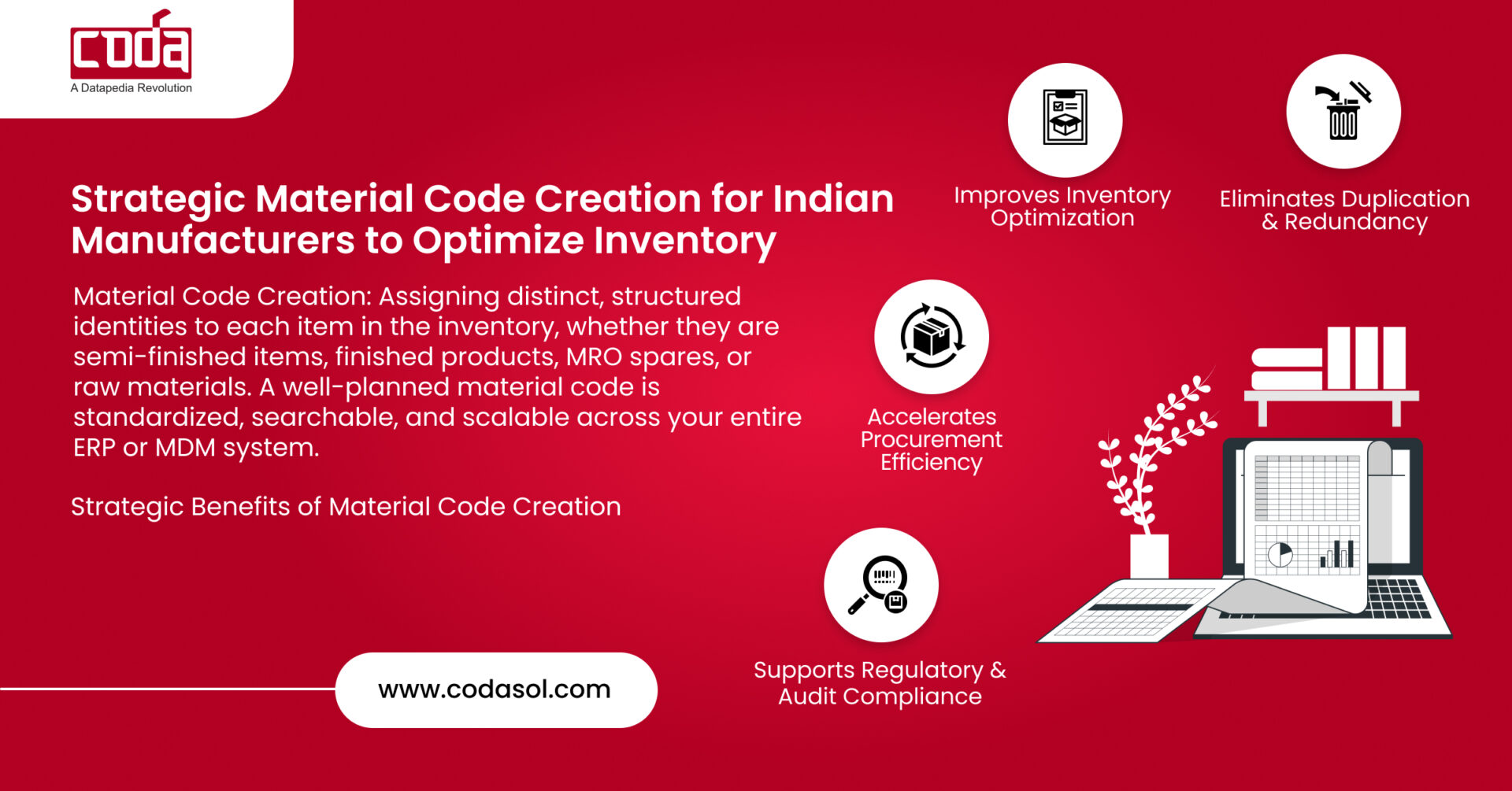Inventory inefficiencies are silent profit killers. From excess stock and stockouts to redundant purchases and poor supplier leverage, Indian manufacturers and industrial sectors across the GCC and Far East grapple with these costly challenges. At the heart of solving this problem lies a powerful but often overlooked tool: strategic material code creation.
In this blog post, we’ll explore the strategic role of material code creation for manufacturers and similar industries in other high-growth regions. You’ll learn how accurate coding improves procurement, enhances supply chain visibility, and enables digitized operations, with real business impact.
Why Material Code Creation Matters
Material code creation is the process of assigning unique, structured identifiers to every item in the inventory — be it raw materials, MRO spares, semi-finished goods, or finished products. A well-planned material code is standardized, searchable, and scalable across your entire ERP or MDM system.
It’s the backbone of:
- Inventory visibility
- Material traceability
- Operational efficiency
- Data-driven procurement decisions
Yet, many businesses in sectors like Oil & Gas, EPC, and Manufacturing still rely on inconsistent or manual coding practices that lead to duplication, procurement delays, and compliance issues.
Strategic Benefits of Material Code Creation
1. Eliminates Duplication & Redundancy
Poorly defined materials can be entered multiple times with different descriptions — think “Bolt M10 x 50mm” vs. “Hex Bolt 50mm M10.” This duplicates inventory, wastes capital, and bloats your ERP system.
Proper material code creation enforces a standard structure, significantly reducing duplicate entries.
2. Improves Inventory Optimization
By assigning unique and logical codes, businesses get:
- Accurate stock levels
- Better demand forecasting
- Minimized stockouts and overstock
This is especially critical in capital-intensive sectors like Defense, Marine, Aviation, and EPC projects where spares can be highly specialized and expensive.
3. Accelerates Procurement Efficiency
When material masters are clean and codified, purchasing becomes faster and more accurate. Vendors receive clear specifications. Internal teams place orders with confidence.
4. Supports Regulatory & Audit Compliance
For government and defence sectors, coding enables easier audit trails, faster reporting, and regulatory alignment across jurisdictions (India, GCC, and Far East nations alike).
5. Enables Digital Transformation
Digital initiatives from predictive maintenance to AI-driven procurement, all depend on high-quality, structured data. Clean material codes are foundational for success in Industry 4.0.
Common Material Coding Systems
| Coding Type | Description | Best For |
|---|---|---|
| Numeric | Sequential numbers (e.g., 100001) | Simpler implementations, scalable systems |
| Alphanumeric | Letters + numbers (e.g., ELEC-CBL-0001) | Categorized items (Electrical, Mechanical, etc.) |
| Intelligent/Smart Code | Code includes part specs (e.g., FLG-CS-150MM-RF) | MRO spares, complex parts, and BOM structures |
| UNSPSC/IS Codes | Global classification standards | Govt & compliance-heavy sectors |
Case Study: How a Healthcare Manufacturer Transformed Material Management with CODASOL’s Prosol
Client Profile:
A legacy healthcare enterprise with manufacturing units in India, the US, and Brazil, offering pharma and animal health products.
Problem:
Disorganized material codes leading to confusion, duplication, and inefficient audits.
Solution Implemented via Prosol:
| Activity | Description |
|---|---|
| Description Validation | Naming conventions aligned with GDSO standards |
| Material Type Correction | Aligned with usage and classification |
| CIN Data Check | Ensured completeness for legal & tax compliance |
| UOM Correction | Verified with issuing & procurement systems |
| 100% Duplicate Check | Daily scans to prevent redundant codes |
| UNSPSC Updates | Categorized materials for global classification |
| Telephonic Amendments | Enabled 24/7 creation and changes |
| SLA Maintenance | Ensured turnaround time of 3 days or less |
Result:
The client eliminated 100% of duplicate entries, streamlined procurement, and passed ICS audit checkpoints without issues. Even during holidays, on-demand support ensured no disruption.
Read the detailed case study:
The Prosol Advantage in Strategic Material Code Creation
CODASOL’s Prosol platform is designed to tackle material master data challenges at scale. Its AI-ML driven capabilities:
- Automatically flag duplicates
- Recommend standard naming conventions
- Integrate with ERP systems like SAP and Oracle
- Assign correct UNSPSC codes and UOMs
- Handle SLA-based material creation requests

Ready to eliminate 12% duplicate inventory and boost ROI by 3x? Start with a free Material Master Audit today.
Regional Relevance:
India:
With initiatives like Make in India and expanding sectors such as Real Estate, Utilities, and Healthcare, Indian companies need structured material codes to scale operations and unlock working capital.
GCC:
Countries like Saudi Arabia, UAE, and Oman are investing in large-scale infrastructure, oil & gas, and smart cities. Material code creation aligns perfectly with these digitization drives.
Far East:
Japan, South Korea, and Singapore lead in industrial automation and supply chain intelligence. Material coding ensures these technologies operate on clean, actionable data.
Implementation Strategy
1. Material Master Audit
Start by auditing your current material master for duplicates, inconsistent naming, and missing specifications.
2. Define Naming Conventions
Standardize your naming structure. Example:[Category]-[Subcategory]-[Size/Type]-[Material]-[Finish]
e.g., PUMP-CENTRIFUGAL-5HP-SS-316
3. Centralize Master Data Management
Use platforms like SAP MDG, Oracle MDM, or CODASOL’s PROSOL to manage code creation centrally.
4. Governance & Workflows
Implement approval workflows and role-based access to avoid uncontrolled material creation.
5. Training & Change Management
Ensure stakeholders from procurement, stores, maintenance, and IT are aligned and trained on the new structure.
Table: Material Code Creation Impact by Industry
| Industry | Impact |
|---|---|
| Oil & Gas | Avoid unplanned shutdowns due to missing MRO parts |
| Utilities | Improve asset reliability and spares visibility |
| Real Estate & Construction | Simplify procurement across multiple projects |
| Marine & Ports | Improve customs & spares classification |
| Healthcare & Lifesciences | Track expiry-sensitive consumables and instruments |
| Banking | Enhance fixed asset traceability |
| Minerals & Metals | Avoid over-purchasing due to inconsistent entries |
| EPC | Streamline procurement across contractors and subcontractors |
| Government & Defense | Ensure compliance and strategic procurement |
| Aviation | Maintain airworthiness with exact part identification |
Frequently Asked Questions (FAQ)
1: What is material code creation?
It’s the process of assigning a unique, standardized code to every material item in your inventory to ensure traceability, eliminate duplication, and improve procurement efficiency.
2: Why is material code creation important in manufacturing?
It reduces inventory costs, speeds up procurement, and supports accurate reporting, all crucial for competitiveness.
3: Can material code creation help with compliance?
Yes, especially in government, defense, and highly regulated sectors. Structured data ensures traceability, auditability, and transparency.
4: Which industries benefit most from material code creation?
All asset-heavy industries such as Oil & Gas, EPC, Defense, Aviation, and Utilities can benefit significantly.
5: How long does it take to implement a material coding system?
Depending on inventory size, it can range from a few weeks to a few months. A phased, governed approach ensures long-term success.
Digitize, Standardize, Optimize.
Join 100+ manufacturers who transformed their inventory with structured material code creation.


